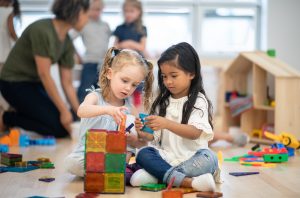Young children use measurement in many of their everyday activities. They compare sizes of toys, portions of food, and lengths of sticks. Eventually their measurement covers much more. Children compare and order by length, area, capacity, weight, time, and temperature. They use non-standard measurement tools such as hands and fingers to estimate length, blocks or squares for area, and sand and water for capacity.
At the same time, young children are gathering data about the world around them. They learn through collecting information on which shapes can enter which holes in a shape sorter, how rotating puzzle pieces often results in a better fit, and how blue and yellow paint mixed together make green paint (and brown if you add many other colors!). We often overlook this constant collecting of data because we are tuned into other types of data activities, like graphs and charts. But life itself is a sort of data-gathering activity.
Understanding how measurement and data are present in children’s everyday life can prepare teachers to promote the development of these key early math skills.
Developing Children’s Measurement and Data Skills
Building children’s math knowledge requires a combination of rich math environments, engaging conversations, and opportunities for children to engage in meaningful activities that require problem solving. DREME developed a robust set of professional development resources for teacher educators to use with teachers as they promote early math skill development.
This blog provides an overview of resources that prepare teachers to grow children’s knowledge of measurement and data. We drew upon research and our own experiences as teacher educators to help teachers design math learning opportunities around mathematical operations that are intentional, developmentally appropriate, engaging, and playful.
Why and What of Measurement and Data: Why engaging with measurement and data is crucial for children’s early math learning.
Mathematics of Measurement and Data: Several different approaches to analyzing and explaining the important math underlying measurement and data thinking.
Development of Children’s Thinking on Measurement and Data: Videos of children practicing math, activities for teachers, and readings that explore how children develop an understanding of measurement and data.
Assessing Measurement and Data: Guidance about assessment approaches so that teachers can identify what children know about measurement and data.
Supporting Classroom Practice: Ideas for teachers to develop their own classroom practices that engage young children in measurement and data thinking.
Vignettes: Fictionalized but very real examples about what it’s like to teach and learn to teach measurement and data.
Getting Started: Teacher educators are invited to use these resources flexibly, with varied settings, amounts of time, and participants. We present a variety of ways to get started with these resources.
Resources Created for and by Teacher Educators
The DREME Teacher Educator website houses a trove of free early math teaching and learning resources, including videos, hands-on activities, handouts, and articles. The materials are flexible and easy to use in a variety of settings, from a professional development workshop to an entire preservice course in teaching math to young children.
The website is organized into modules addressing early math content areas, plus an Overview section:
We recognize that children come to school with diverse experiences and math-related knowledge that teachers can harness. Our materials focus on developing the ability of teachers to promote deep mathematical understanding in all children.



